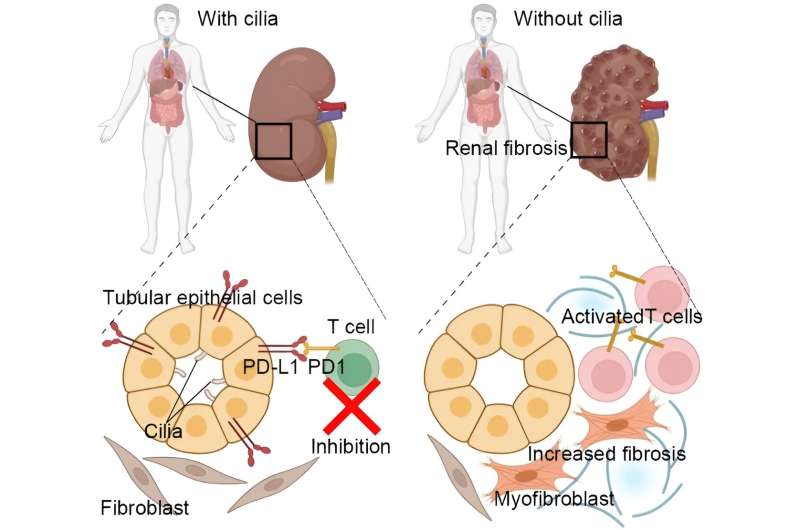This article has been reviewed according to Science X's editorial process and policies. Editors have highlighted the following attributes while ensuring the content's credibility:
fact-checked
trusted source
proofread
Study finds primary cilia restrict autoinflammation by mediating PD-L1 expression

Ciliopathies are multisystem disorders characterized by the dysfunction of motile and/or non-motile cilia, which show common clinical manifestations of ciliopathies include retinal degeneration, mental retardation, renal abnormality, obesity, and skeletal dysplasia. Fibrosis of vital organs, characterized by the extensive deposition of extracellular matrix components, represents another complication frequently observed in patients and animal models of ciliopathies. However, the precise mechanism that connects ciliary defects to fibrosis remains largely elusive.
The recent study led by Dr. Min Liu (Haihe Laboratory of Cell Ecosystem) and Dr. Yunfan Yang (Shandong University) showed a role for autoinflammation in the onset of ciliopathies. They found that T cell infiltration and attenuated expression of PD-L1 in ciliopathic tissues. Loss of cilia in epithelial cells downregulates PD-L1 and leads to T cell activation.
The paper is published in the journal Science Bulletin.
The initiation and progression of fibrosis are substantially influenced by the infiltration of immune cells, including T cells. Indeed, immune cell infiltration and inflammation can be observed in cilium-deficient fibrotic liver and kidney of ciliopathic patients and animal models.
In mouse models of renal fibrosis, the expression of major histocompatibility complex class II (MHCII) is enhanced in renal tubular epithelial cells (RTECs), leading to the proliferation of CD4+ T cells and the pathogenesis of renal fibrosis. It remains to be verified whether the fibrotic phenotype in ciliopathies is a consequence of excessive immune responses caused by cilium deficiency, which may establish a role for autoinflammation in the development of ciliopathies.
The connection between ciliopathies and the immune system has been largely overlooked due to the absence of cilia on immune cells. Recently, it has been reported that certain ciliopathic patients have an elevated susceptibility to autoimmune diseases, suggesting that cilia may play a role in immune tolerance.
To determine a potential effect of cilium deficiency on autoimmune response, the team generated conditional knockout (KO) mice of intraflagellar protein 88 (IFT88), which is a key ciliary protein and loss of which is embryonic lethal in mice, by injecting Ift88flox/flox; Ubc-Cre/ERT2 mice with tamoxifen. They found that IFT88-KO mice, but not WT mice, displayed fibrosis in the kidney and liver at an advanced age.
Furthermore, an enhanced infiltration of CD4+ and CD8+ T cells was observed in the fibrotic tissues of IFT88-KO mice, as well as enhanced renal T cell activation. Notably, T cell infiltration was detected prior to the progression of fibrosis, supporting a role for T cell infiltration in the development of fibrosis.
A significant reduction in PD-L1 expression and surface manifestation was detected in IFT88-KO mice in comparison to WT mice. Furthermore, the protein level of PD-L1 was also decreased in the kidney, liver, and lung of IFT88-KO mice.
At the cellular level, they found that RTECs, which constitute the major cilium-containing cell type in the kidney, expressed PD-L1 at the highest level. Loss of IFT88 in mRTECs (an immortalized murine cell line of RTECs) disrupted primary cilia and downregulated PD-L1 at both mRNA and protein levels, suggesting that primary cilia maintain PD-L1 expression in a cell-autonomous manner. Consistently, pharmacological removal of cilia in mRTECs using ciliobrevin A or chloral hydrate downregulated PD-L1 expression, indicating that primary cilia play an important role in maintaining the expression of PD-L1.
PD-L1 is a co-inhibitory molecule that suppresses T cell activation and has been implicated in the progression of auto-immune diseases. To define the function of cilium-mediated PD-L1 expression in the regulation of T cells, they co-cultured HK-2 and T cells in vitro, and demonstrated that HK-2 cells could inhibit the activity of T cells, while this effect was substantially mitigated by the removal of primary cilia from HK-2 cells. Collectively, these findings indicate that primary cilia play essential roles in maintaining PD-L1 expression and restricting T cell proliferation and activation.
Excessive T cell proliferation and activation have been previously observed in ciliopathies, but the underlying molecular mechanism remains poorly understood. In this study, the authors demonstrate that loss of primary cilia results in the downregulation of PD-L1 expression, which contributes to unrestrained local T cell proliferation and activation.
In this context, ciliopathies are probably an outcome of immune disorder resulting from the disruption of PD-L1–mediated immune tolerance. Further studies are warranted to determine the extent to which immune disruption leads to various ciliopathic phenotypes and to determine whether immunotherapies could be beneficial for ciliopathic patients.
Overall, this study reveals the functions and molecular mechanisms of cilia in T cell activation, indicating the potential role of autoinflammation in ciliopathies, thus providing new strategies and potential targets for the treatment of related diseases.
More information: Xiaoyu Tian et al, Primary cilia restrict autoinflammation by mediating PD-L1 expression, Science Bulletin (2024). DOI: 10.1016/j.scib.2024.03.039




















